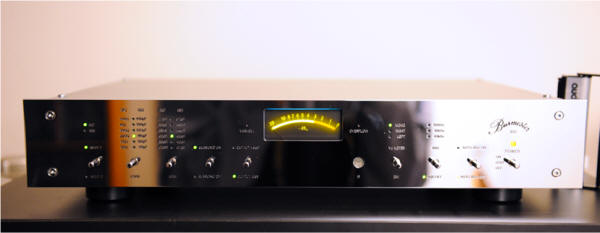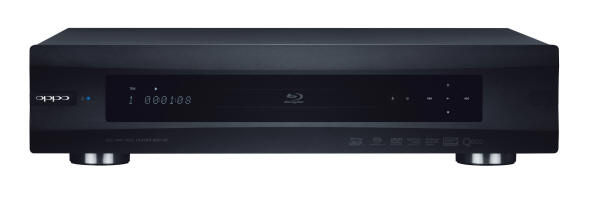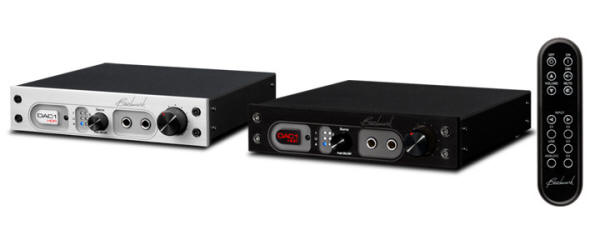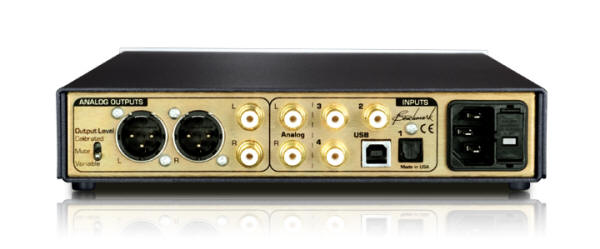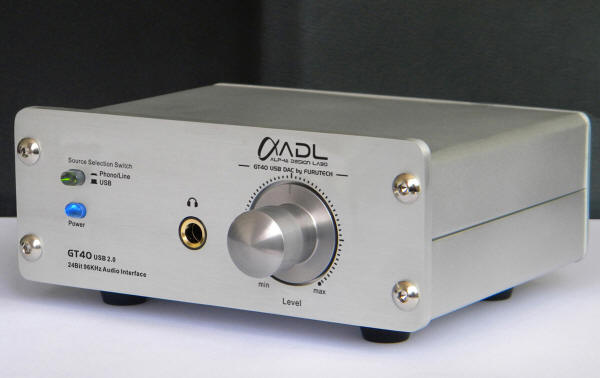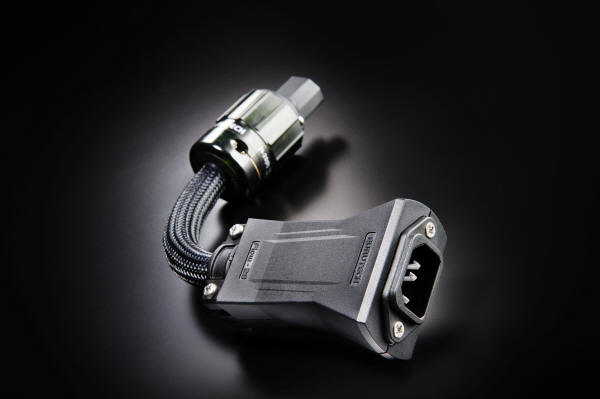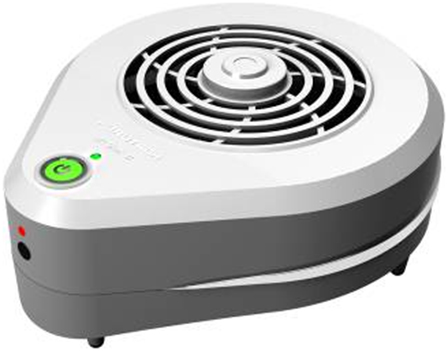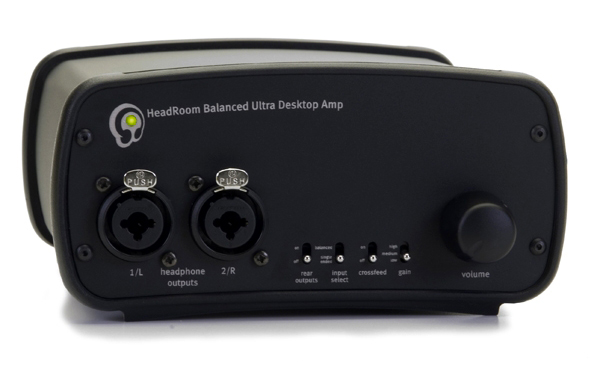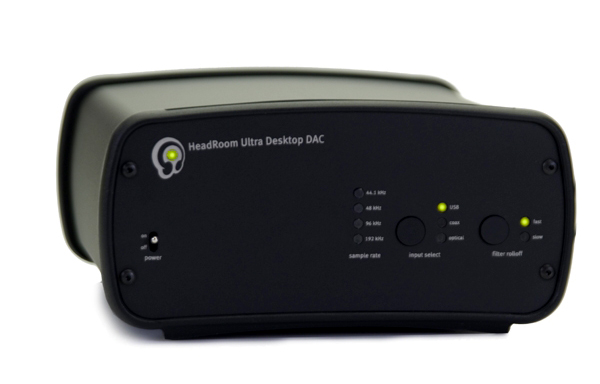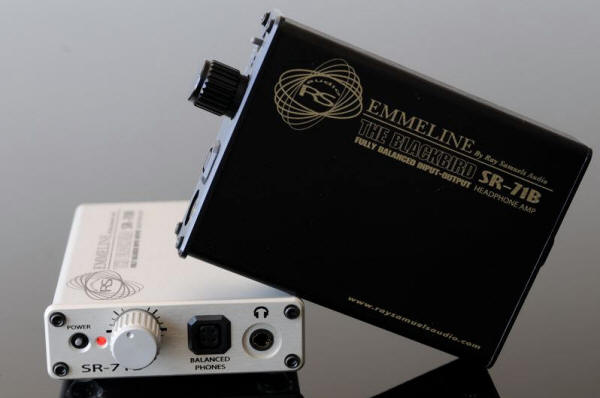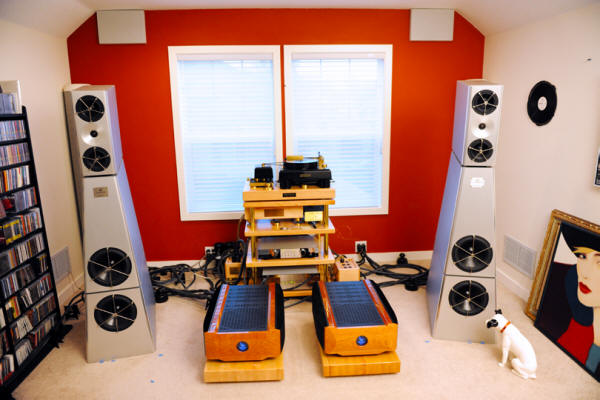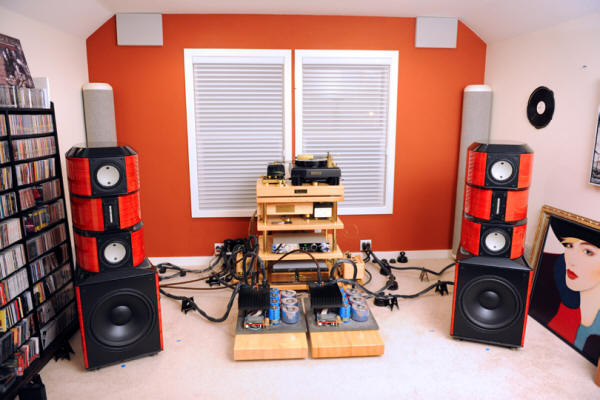|
You are reading the older HTML site
Positive Feedback
ISSUE
58
Impressions: My Brutus Awards
for 2011, Part 2
[All photographs and image processing by Robinson, unless otherwise noted.] Burmester 100 Phono Amplifier
Some of the designs that came in for consideration in my listening room in 2011 arrived late in my review cycle for the year. Sometimes I have time to give them a listen before I issue my Brutus Awards for the year; sometimes I don't, if they arrive too late, or at a time when I cannot immediately get them into play in our listening room. In that case, they wait until next year… assuming that they qualify for a Brutus at all. Burmester was a name that I knew, of course, but had never heard in my listening room. I met Robb Niemann, CEO of Burmester Northa America, late last summer at an audio seminar. He is a great fellow, and was quite willing to supply me with some review samples of the Burmester line. To date, these include the 088 preamp (kid brother to the 808 Mk 5 reference preamp), the 948 Power Conditioner, and the 100 phono amp. I'll be sharing my impressions of these in 2012, but I want to focus on the brand new product that Burmester has just launched: the 100 phono preamp, with integrated A/D converter (48kHz/96kHz/192kHz options). In fact, this product is so new that it still isn't even listed yet at the Burmester English-language site. In the case of the Burmester 100 phono amp, it just so happened that we were getting ready to install the Wave Kinetics NVS turntable, Durand Telos tonearm, and Ortofon A90 MC cartridge. The obvious opportunity was there to put the 100 into place, instead of using the very fine MC section of the darTZeel NHB-18NS preamp (our previous plan), which I had already recognized as world-class with a Brutus Award back in 2010 (see Issue 52). And so we did, and just in the nick of time to be considered for a Brutus Award in 2011. As is true of all Burmester gear, the 100 is a true jewel, so beautifully crafted in chrome that it's mirror-like in its frontal presence. The metalworking and plating alone must cost a fortune. It's a very solid piece of work, tipping the balance beam at 21 pounds. The dimensions are 19" wide x 3.7" high x 13.6" deep. The very useful front switches include (from left to right) MC/MM input type selection; MC/MM loading (MC options = 33/75/220/390/1k/47k Ohms; MM options = 68/120/180/220/300/400pF); MC/MM gain (MC options = 57/60/63/66/69/72dB; MM options = 37/40/43/46/49/52dB); subsonic on/off; output 0dB/+6dB; VU meter indicates left/right/stereo; ADC = 48kHz/96kHz/192kHz; auto adjust (for equalizing left/right imbalances from the cartridge) on/off; and power on/standby/off. The soft-action switches are a kinesthetic delight, having a great combination of solidity and elegance… and yes, there really is an aesthetic of touch. And the Burmester has it. After 3-4 days of burn-in, recommended by Burmester, I began some first-impression listening. I didn't really know what to expect, since this was my first experience with Burmester in my room. I needn't have worried! I'll do a more complete report in 2012, but I can tell you that the splendid Wave Kinetics NVS turntable/Durand Telos tonearm/Ortofon A90 MC took to the Burmester (with settings of loading = 220 Ohms [after some experimentation], and gain = 63dB, known good for this MC) like the proverbial duck in water. Within days it became very clear to me that the Burmester 100 was a very obvious Brutus Award winner, and that I shouldn't wait to let you all know about it until December of 2012! Exceptionally quiet; very detailed; extremely neutral; highly configurable; and all of this with an integrated ADC to boot…what's not to like? In days the 100 vaulted into the very first rank of reference grade phono amps that I've had in my listening room, and that is a very difficult thing to do, amigos…I've heard a fair number of them. Most phono amps have one thing or another that I'd like to see improved; so far, the 100 has been nothing but a joy. So now you know. If you are looking for stellar quality in a phono amp, with an absolutely terrific set of controls, and an integrated high-resolution A/D, I think I can tell you that the Burmester 100 is it. A 2011 Brutus Award winner for sure, with my very highest recommendation! Oppo Digital BDP-95 Universal Player
The terrific Oppo BDP-95 Universal Player, Robinson's "Swiss army knife of digital playback" (image courtesy of Oppo Digital) Well, what can I say? Oppo has done it again: produced the Swiss army knife of digital playback, with their BDP-95 universal player. It supports just about every optical disc format that you would need, including SACD, Blu Ray audio formats, DVD-A (up to 192kHz/24 bit), CD, HDCD, .MP3 discs, .FLAC discs, .WAV discs… just about everything except pure DSD files (e.g., .DFF or DSDDIFF). And I wouldn't be surprised if Oppo didn't include playback of DSD files in the near future… it would be smart thing to do given the movement towards DSD downloads now developing. These folks are very savvy about supporting audiophile formats.
The BDP-95 includes outputs that handle 7.1 channels if you're using it in a home theater/surround music system, but there are also dedicated stereo outputs, both balanced and unbalanced, for pure stereo use. The Sabre32 chipset produces surprisingly good sound; indeed, I have spent countless hours here in my PFO editorial office, listening to the Oppo BDP-95 as the source for my desktop systems. Both the balanced and unbalanced outputs work great for stereo use; multi-channel fans can have 7.1 via the unbalanced outputs. I like the way that Oppo has provided two HDMI outputs, so that video and audio streams can be separated for better performance. External DACs can be serviced by S/PDIF, TOSLINK (ech… I'd love to see AES/EBU and/or ST Glass, but know that this is too much to hope for at this price point), or HDMI. E-SATA and USB are supported for digital files, and composite and component video are also present. There's a LAN connector for updating the firmware and pulling in Blu Ray content… they work very well, and I've never had a problem with my firmware patching. The Oppo BDP-95 is also nicely modable and tweakable; there are several companies (e.g., ModWright) who are producing very good upgrades for the BDP-95. This is another triumph for Oppo Digital, and one of the biggest no-brainers in quite a while when it comes to my "bang-for-the-buck" Brutus Awards. At its price, who can argue with it? For more details, and to order, check out the Oppo site. Consider this to be a "highly recommended!" product, and a winner of a 2011 Brutus Award…with real affection! Benchmark DAC1 HDR D/A
The Benchmark DAC 1 HDR in silver and black, with remote (all images in this section courtesy of Benchmark) At the other end of my trusty-rusty Oppo BDP-95 and my computer-based audio (HP Pavilion DV-8T) in my office here have been several DACs for evaluation with headphones… in 2011, the superb Sennheiser HD-800 balanced 'phones as the constant for review, and itself evaluated. The first of these is the Benchmark DAC1 HDR (for High Dynamic Range) D/A and preamp. Benchmark has been receiving high praise for its excellent PCM DACs from the audio press generally, myself included. The earlier DAC1 received a Brutus Award from me as a tremendous bang-for-the-buck product that had over-achieving sound quality. The reason is simple: at relatively reasonable prices, Benchmark provides excellent digital conversion and audio performance in a very compact package. This tradition of over-achievement continues with the DAC1 HDR. Going well beyond the very fine Benchmark DAC functionality, the HDR is a stereo preamp with DAC, with a nice set of I/O and switching options.
The inputs include four digital options (TOSLINK, plus three S/PDIF inputs, and a USB A connector), and one RCA analog pair of inputs. Outputs are both unbalanced and balanced out. A handy and sophisticated remote control allows the handling of power, volume, dimming, muting, and input selector. The only thing I miss is phase inversion, which would have been useful. Switching for output levels include Calibrated, Mute, and Variable (which is what I use).
The front panel has a power on knob that doubles as an input selector, plus a pair of ¼" stereo headphone jacks (great for audiophile dates!) and a large Alps motor-driven potentiometer (their High Dynamic Range Volume Control, or HDR-VC) that handles both digital and analog volume without the usual trade-offs involved with one or the other. Also integrated is the Benchmark HPA2™ 0-Ohm headphone amp. This is what I used to listen to the DAC1 HDR. During this review, I used the USB input at the usual pukey 96kHz/24-bit resolution that Windows 7 supports, and also the S/PDIF for resolutions out to the max resolution of 192 kHz/24-bit. There was no problem in hooking the DAC1 HDR to Windows 7; it came up in seconds, with no special driver loads. The S/PDIF, hooked up to my Oppo 95, handled everything from 44.1kHz/16-bit out to 192kHz/24-bit, including the sometimes problematic (with some DACs) 88.2kHz and 176.4kHz rates. Very smooth on the switching… no pops or problems there. I used the Sennheiser HD-800s (balanced) via a Cardas balanced-to-¼" cannon jack to evaluate the Benchmark. The results were excellent: the highly revealing HD-800s showed the DAC1 HDR to be a splendid preamp with headphone function… in fact, a great headphone amp. The superior resolution of the DAC1 was immediately apparent, with a clean, clear presentation of the music. Naturally, the higher the resolution of the source recording on the Oppo, the better the sound, with generally enhanced spaciousness, detail, and a smoother resolution of strings. I have a growing library of HDTracks sources, plus some other samples of high-resolution PCM (DADs, HDADs, DVD-As, .WAV, and .FLAC) that allow me to really work-out a higher resolution PCM DAC. There was no harshness, grain, or sense of a headphone amp being over-driven, regardless of volume… though I value my hearing well enough to stay far away from ear-bleed levels. (Just call me rational.) My conclusion after listening: the Benchmark DAC1 HDR is a for-real mighty-mite preamp! At $1895, it gives the budding audiophile, the audiophile-on-a-budget, or the 'phile looking for an office, desktop, or bedroom all-in-one for headphones a superior, compact solution. Very highly recommended, and hereby awarded one of Robinson's Brutus Awards for 2011! Furutech GT40 USB DAC, Flow-28 AC Filter, and DeStat II
The Furutech GT40 96/24 USB D/A and A/D Converter and Headphone Amp (all images in this section courtesy of Furutech) I've already reviewed and praised the Furutech GT40 and Flow28 AC Filters in Issue 57 of PFO. There's nothing that I would add to that commentary. The GT40 and Flow28 AC filters are first-rate components that bring obvious quality and functionality to my reference desktop system, and so recommend them with Brutus Awards here in 2011. The Furutech Flow28 AC Filter… it makes an unmistakable improvement in the sound!
To that list I would add another product from Furutech: their new DeStat II static-neutralizing component. This is designed to be used in conjunction with their degaussing models (e.g., the RD-2, or their large and powerful Demag LP/SACD/CD demagnetizer). The Furutech DeStat II
This unit replaces the earlier DeStat that I am still using for my desktop system. The earlier DeStat was strictly a hand-held design, which was useful for many operations, but did not allow the user to set an SACD, Blu Ray, DVD, or CD in place for hands-free static neutralization. The new model not only has feel to allow hands-free, but has also doubled the number of ion emitters from two to four for more effective static zapping. LPs can be dealt with by simply holding the DeStat II over the album on the platter within a few inches of the surface, and gently going around the LP while the fan blows the ion flow downwards to the surface. Works great on both optical discs and LPs! The unit supports both 10 and 20 second treatment times. I've found that the best results are obtained by first using a Demag unit, and then following with a destat treatment before firing up the playback. You should notice a clearer, more detailed presentation after this one-two punch… very effective! So here's to Furutech for helping us to get every bit of each bit and every groove out of the groove that we can! Definitely recommended, and a third Brutus Award to Furutech for the deStat II! HeadRoom Triple-Stack Balanced Ultra Desktop Package, with the optional Sennheiser HD-800 headphones (balanced) with Cardas Clear Balanced Cable and Sennheiser Connectors [All images courtesy of HeadRoom]
Back in PFO Issue 46 I reviewed the HeadRoom Desktop Reference System, and gave it very high marks for turning my office desktop into a very pleasant place to work while listening to music from the Oppo 83 Signature Edition player. That was a very fine combination. As a follow-up, HeadRoom was good enough to send along their Triple-Stack system, as listed above ($3199), and with the Sennheiser HD800 balanced headphones (MSRP $1949.95; HeadRoom price of $1649.95). I evaluated it with Cardas balanced cables for the Sennheiser line, and a HeadRoom balanced-to-¼" stereo jack adapter (used on the Benchmark DAC1 HDR, as listed above). They also included DiMarzio balanced interconnects, but I skipped that in favor of the JENA Labs balanced Symphony cables, which are definitely superior to my ears, and are a long-time reference for me. Likewise, I skipped the standard generic IEC power cable in favor of the JENA Labs five-strand power cable… don't brickwall this system with pukey power cables! I've worked my way up in the Sennheiser line, having heard various of the 5xx and 6xx series; it was definitely time to try the HD800 balanced headphones that I had heard so much about. The Balanced Ultra Desktop Amp (affectionately known as "BUDA" over at HeadRoom) is a compact and full-featured headphone amp, with balanced and unbalanced inputs, unbalanced outputs, and a DIN connector for the power supply. (Given the lack of speaker connectors, I am assuming that the BUDA is an "amp" for balanced headphones, while acting as a preamp if you wish to use speakers and their associated amplification.) There are two balanced jacks for headphones up front, with switches for rear outputs (on/off), input select (balanced/unbalanced), crossfeed (this allows a certain degree of left and right channel mixing in playback, on/off), and gain (high/medium/low), plus the volume pot.
The HeadRoom Ultra Desktop DAC is HeadRoom's top DAC. Using the same form factor as the BUDA and the Desktop Power Supply, this unit provides inputs for USB, S/PDIF, and TOSLINK. Note that the USB port is not the more common USB-A connector; instead, HeadRoom opted for a mini-USB connector, which will affect your choice of associated higher-end cabling. Outputs include balanced and unbalanced ports. A DIN connector for power rounds out the back end of the Ultra Desktop DAC. The front has a power switch, LEDs to indicate the sampling rate being processed, a three-way input selector (USB/coax/optical), and filter roll-off (fast/slow). All of this was powered by the HeadRoom Desktop Power Supply, instead of the generic alternative. I do not consider this to be optional; if you are going to invest in the higher end of the HeadRoom line, then you must go with this power supply. HeadRoom kit has always sounded better with proper attention to the power supply and cabling; the JENA Labs cabling and this p/s has been a reliable combination every time I've listened to HeadRoom over the years. Due to the fact that all units have the standard HeadRoom higher-end form factor, and were grooved for stacking, I saved space on my desktop by doing just that: a three-story structure! The sonic results with the HeadRoom Triple Stack using S/PDIF (cabled with Chris Sommovigo's excellent Black Cat coax), interconnect- and power-cabled with JENA Labs, and the Sennheiser HD800 via the standard Cardas balanced headphone connectors was very fine indeed. After a week or so of warm-up, the combination seemed to hit its stride. I used a series of recordings of various formats and recording resolutions to evaluate what I was hearing. These included standard CDs at 44.1kHz/16-bit, plus higher resolution recordings at 88.2kHz/24-bit, 96kHz/24-bit, 176.4kHz/24-bit, and 192kHz/24-bit. I did not have anything at 48kHz, and so did not try that… more about this in a moment. One thing that I did notice in my listening was that the Ultra Desktop DAC did not have LEDs for 88.2kHz and 176.4kHz. I wondered how it would handle source recordings in those formats, and broke out some of my MA Recordings high-resolution files to test 88.2 kHz/176.4kHz, as well as my library of HDTracks recordings. As I suspected, when those two resolutions came up, the DAC shifted to the next lower resolution to handle the resolution. 176.4kHz files dropped to 96kHz; 88.2kHz dropped all the way to 48kHz. I consider this to be an unsatisfactory way to handle these file resolutions, which do exist in the marketplace, and ought to be supported transparently at the DAC level. Apart from this consideration, the audio presentation at all resolutions was handled by the HeadRoom Triple-Stack, as configured, with excellent transparency and quickness. The noise floor was exceptional; no white noise or other nasties, even at very high gain. I would rate the performance with the sources that I used (MA Recordings, HDTracks, Classic Records DAD (96/24) and HDAD (192/24) to be superior, subject only to the problem with 88.2 and 176.4kHz files. Certainly the HD800s were sounding better than the earlier 600 and 650 models that I had heard… much more musical, with richer harmonics, while preserving detail, and providing very fine imaging. UPDATE: The quality of the HeadRoom Triple-Stack was confirmed and extended when George Cardas (through the help of good audiobuds Andy and Sue Regan, who are now at Cardas Audio) were able to get me an advance pair of the new Cardas Clear balanced headphone cables for Sennheiser, complete with their new Cardas Sennheiser connectors, at the very last minute. The previous Cardas cable for Sennheiser had used the Cardas gray-jacket connector, and were certainly better than the other cables from HeadRoom that I had tried (e.g., Sennheiser)… but these new Cardas Clear balanced cables simply soared, and left the earlier alternatives far behind! Only a few days of break-in, and the performance of the entire HeadRoom stack moved up a full notch or two, as the Cardas Clear made the quality of the system… well, clearly apparent. The Cardas Clear also underlined the exceptional performance of the Sennheisers. These HD800s are terrific! Enough said. The final system, as described, was outstanding. I therefore give the HeadRoom Triple Stack Desktop Reference System, with the Sennheiser HD800 balanced headphones, the Cardas Clear Headphone Cables with Cardas Sennheiser Connectors, the Black Cat S/PDIF coax cable, and JENA Labs power cord and Symphony XLR cables, a 2011 Brutus Award… enthusiastically! Ray Samuels Audio Emmeline SR-71B Balanced Headphone Amp
[Image courtesy of Ray Samuels Audio] This is rather an unusual award, due to the interruptions and tight timeline that was involved. Early in the year, Ray Samuels sent me his Emmeline SR-71B ultra-compact headphone amp. This is the balanced version of his well-received SR-71 amp, allowing connection to balanced headphones via a unique proprietary adapter. A rechargeable battery-powered amp, the SR-71B allows maximum portability for the on-the-go audiophile seeking very high quality in portable playback. I became aware of Ray by reading my own magazine (tah-dah!) and through the direction recommendation of Jerry Harvey of JH Audio when I got a pair of his phenomenal JH16 Pro Custom In-Ear Monitors a year ago (see my 2010 Brutus Award for the JH16's. Jerry told me face to face that I wouldn't hear his JH16s sound their best unless I was using them with Ray Samuels' amplification. As I noted in my above-cited 2010 Brutus Award comments for the JH16s: My experience with the JH16 Pro's since then have confirmed that these are very special in-ear devices. With double dual-low drivers, single dual mid drivers, and single dual high drivers, integrated three-way crossover network, and an in-ear rated frequency response of 10Hz to 20kHz, your ears won't die of sonic thirst. Certainly, they have put other in-ear devices that I've used to shame, and by a country parsec. With the growing ubiquity of portable music of reasonable quality, and the amount of traveling on jets (and waiting in bloody airports!) that I do, the JH Audio JH16 Pro's are making a major difference in my enjoyment of my iPod 5.5, iPhone 4, and computer-based music on the road. Being custom fitted to my ear canals, the JH16 Pro's are comfortable for longer-term listening. They also seal out a huge amount of background noise in jets, allowing me to listen at comfortable levels with the volume turned down significantly, compared to my prior levels with other in-ear buds. In fact, they're so good that I'm going to do a follow-up evaluation of the JH16 Pro's with a new portable amp design from Ray Samuels Audio. We'll see how that turns out in 2011. Well, I was able to get Ray Samuels to send along an amplifier early in 2011, but it was his new SR-71B balanced ultra-compact amp. If you'll refer to Ray's website images listed above, you'll see that it is a very tight form factor, being about the size of an iPod or iPhone. Ray was also kind enough to send along his personal pair of Sennheiser HD800 balanced headphones, with a special adapter for converting the proprietary balanced output of the SR-71B to balanced connectors for the HD800s. There was also a handy Apple connector adapter (Apple-to-1/8" stereo) to allow me to hook-up my trusty iPod 5.5 to the SR-71B directly, bypassing the use of 1/8" stereo connectors at one end, thus assuring better quality sound. Finally, he sent along an adapter that would allow balanced-to-proprietary balanced input. Ray strongly recommended that I try balanced sources for his amp as the ultimate in quality for evaluation, which I agreed to do. When it arrived, I was really taken by the size and heft of the SR-71B, as well as its logical and attractive layout. The back-side of the unit contains a DC input for charging the battery, and for continuous operation when near AC power supplies; dual-mono left and right gain switches (medium/high/low); a proprietary balanced input port; a balanced/single-ended input switch; and a 1/8" single-ended stereo input port. The front of the SR-71B features a power switch, a very solid volume pot, a proprietary output port for the balanced output, and a standard 1/8" single-ended output port. Reading the description of Ray's internals on this design confirmed that this was a very thoughtful piece of work. It's a truly balanced layout, front-to-back, with four separate mono circuits, two per channel, to provide the real thing. Single-ended input is rendered balanced with a phase splitter; balanced is balanced throughout. The power supply is as clean as you can get; the circuit paths just about as short as you can get them from input to output. On paper, this was a very sweet piece of work. I was really looking forward to checking this out with both single-ended and balanced sources, with both inputs tried into the JH Audio JH16 Pros (single-ended) and the balanced Sennheiser HD800s. But this would take time, and as it turned out, the system that arrived in January would need to leave by the end of March. Normally this would be doable, but the timeline was tight given my other projects, made even tighter by the passing of my Mom in late February, mandating a trip to California in early March. Things couldn't have been harder, as I'm sure that you all understand, and I was hard pressed to put in the necessary time to gather my impressions of the SR-71B. Nevertheless, I was able to spend just enough time to get the feel for what the SR-71B brings to the table. Many of us are familiar with the sound of iPods, iPads, iPhones, and other 1/8" compact portable audio devices. Leaving aside the dreary compression used on their files, the audio electronics that are aboard the playback units have been shoe-horned into extraordinarily small spaces. They share power with a number of other functions, and don't do a lot more than help you to overcome the local noise floor, more or less successfully. (Often less, depending on your headphones or ear buds.) The results have been disappointing for me: rather thin, edgy sound, with a degree of grain, particularly with the standard-issue Apple ear buds, which suck major swamp water. Dynamic range is relatively unsatisfying, and the lack of harmonic richness leads to a deficit of musicality. It's very mediocre; its only virtue is its portability…and we're paying a high audio price for that. I'll listen to it, but mainly because:
The use of better phones helps somewhat, but doesn't overcome the limitations of the onboard electronics in an iPod/iPad/iPhone/whatever. In fact, better 'phones make the limitations of the playback electronics really obvious. There has to be a better solution that doesn't kill the portability of these devices, which are their main charm. In fact, there is. I'm happy to report that Jerry Harvey was right: the SR-71B changed the experience of my iPod 5.5 fundamentally. My JH16 Pros lit up immediately via the 1/8" stereo jack. With all recordings (I have some 5000 or so on my iPod 5.5) there was a greater dynamic range, much richer harmonic structure and tonal integration, a lower noise floor, and something that was a lot more like music-on-the-go, rather than give-me-a-break! I felt like there was a real foundation under the music for my iPod, for the first time, instead of dealing with music that sounded like the underlying electronics were having to strain to drive the JH16 Pros. So I can say that users of JH Audio In-Ear Monitors will benefit significantly by using the Ray Samuels Audio SR-71B. The SR-71B was much better, however, when I drove it in my office with balanced sources…in this case, the balanced output from my Oppo BDP-95, which is a good performance and price match. The sonic presentation was quieter, even more dynamic, with greater transparency and better handling of harmonics. This was especially evident when I ran balanced out with some of my SACDs through the BDP-95… now I was hearing what the JH16 Pros could do! I confirmed this even more convincingly with the over-the-ear presentation of Ray Samuel's personal pair of Sennheiser HD800 balanced phones. (At this point in the year, I did not yet have the Cardas Clear balanced for the HD800s in hand, and so auditioned with Ray's cables and connectors.) The difference was even more starkly drawn: balanced sources were outlined with remarkable delineation and texture. Dynamics were now grand, and the harmonics were extremely rich and definitely musical with any SACD that I pitched at the SR-71B. Early-in-the-year (2011) SHM SACDs figured prominently here, including some Cream (Wheels of Fire), Dire Straits' eponymous, likewise Blind Faith, John Mayall and the Bluesbreakers, some Bill Evans, some Rolling Stones, a touch of Stevie Wonder, Mozart's Requiem… time was limited, and so I moved quickly. I certainly couldn't quibble with the results; the SR-71B, this compact beastie, was compelling with these ultra-quality, truly delicious SHM SACDs in balanced mode. What else need I say? I've already gone on at some length here…longer than I intended, actually…because despite the short time I had with the SR-71B, the favorable impression that it created stayed with me all year long. And that says a lot. I am therefore awarding the Ray Samuels SR-71B a Brutus Award for 2011… this is definitely a high-quality component for the mobile-and-compact audiophile! Ray Samuels Audio Emmeline SR-71B "The Black Bird" fully balanced input/output headphone amp, MSRP USD $650. Accessory cables can be quoted at need. Call 847-673-8739 for more information, or to order; email is [email protected]. Music Awards My Brutus Awards for music in 2011 include the following companies: Chad Kassem, Analogue Productions, and Quality Record Pressings What can you say? Chad & Company are producing the highest quality LPs and SACDs you can find these days. That's not to say that others aren't doing great work, but Chad has demonstrated a life-long passion for preserving and reissuing terrific recordings to those who love them, worldwide. In the past year, the Blue Note reissues, the Verve reissues, the acquisition of Classic Records, the installation of his own record-pressing plant and label, Quality Record Pressings (200 grams returns… again!), the Pink Floyd Wish You Were Here surround project with James Guthrie (Chad always does his homework on getting the right A&R), the killer quality of his vinyl and his nextgen pressings (Cat Stevens, Muddy Waters, Getz/Gilberto, Springfield… with the Doors coming soon, and on both LP and SACD!)… I can think of tons of reasons why Chad and his people deserve this award. If you aren't jumping on his reissues, then you're crazy, amigo! Enough said! Time to give Chad Kassem and company a 2011 Brutus Award for music… with the highest enthusiasm! David Chesky and HDTracks I've been following HDTracks for quite a while now (for example, see the podcast of my interview with him all the way back in Issue 49, wondering when the Cheskys were going to hit critical mass and gain significant momentum in the marketplace. Looks like that's exactly what happened in 2011! Terrific labels and artists, great recordings, and higher resolutions available in some titles… all the way out to 192kHz/24-bit .FLAC in some cases. Now that increasing bandwidth has itself hit critical mass in so many places, I expect that we'll be seeing more and more from HDTracks. With 192kHz/24-bit PCM becoming more commonplace, can downloadable DSD be far behind? I hope not! So, once again, a Brutus Award in 2011 to the Cheskys and their team at HDTracks! Winston Ma and First Impression Music's UltraHD™ CDs In the world of Red Book CDs, Winston Ma continues to make the case for maximum quality at 44.1kHz/16-bit discs. His latest foray is his UltraHD™ mastering system, utilizing up to 192kHz/32-bit resolution, carefully matched to source materials, to produce extremely high-resolution masters. These are then used in a meticulous process to produce Red Book CDs of an extraordinary quality for that format. To assure maximum quality, Winston has assembled a team of exceptional engineers, including Michael Bishop, Robert Friedrich, and Thomas C. Moore of Five/Four Productions to handle the audio mastering. The UltraHD™ mastering process is exclusive to Five/Four Productions, and represents the collective quality and experience (to date!) of a top-notch company. It's no surprise that the quality of these CDs is the best I've heard in Red Book! I spent some time evaluating some sample CDs that Winston was kind enough to send to me. I have to admit that while my very strong bias is for DSD (at either 64fs or 128fs) for optical discs and ultimate fidelity, FIM's UltraHD™ CDs are truly stellar for that format. If you would like to hear how good CDs can sound, you owe it to yourself to own some of these discs, which surely represent the zenith of what Red Book is capable of. Not sure where to start? You can't go wrong with his The Producer's Choice series. His classical and jazz reissues will be familiar to connoisseurs of those genres; I haven't found a dud in any of these. All of this is worthy of a 2011 Brutus Award to First Impression Music! Todd Garfinkle and MA Recordings A passionate artisan of world music, Todd Garfinkle has been making truly spectacular recordings for many years now. Dozens and dozens of titles have resulted at his label, MA Recordings. Bringing a purist and minimalistic approach to the art of recording, Todd has rejoiced my soul on a number of occasions with delightful music from all over the planet. His breadth and diversity of artists and their music is breathtaking. In the past few years, Todd shifted upwards from recording in 96kHz/24-bit PCM to doing his work in DSD at 64fs and even 128fs using a Korg DSD recorder. I have heard the results at a number of shows, where his work in DSD has made truly beautiful music flow in his demonstration rooms…usually in the company of his good friend (and mine), Chris Sommovigo. This shift in format and advances in digital technology have allowed Todd to issue his recordings in high-resolution (from 88.2kHz up to 176.4kHz/24-bit) .WAV files. These uncompressed LPCM files give a great sense of the atmospheric and transparent quality of Todd's work as a recordist. His latest recordings are all a delight… Sera Una Noche, the high-resolution Bach recordings, Llama, and Puente Celeste Nama being particular favorites of mine. Exceptional recordings, from an exceptional and prolific audio artisan. A 2011 Brutus Award for Music is deeply deserved by Todd Garfinkle and MA Recordings, and hereby given! Universal Japan for its SHM SACD series Wow! What can I say? I have been following Universal Japan's SHM SACD reissues for over a year now. These are very high quality re-masters that are produced on single-layer, stereo-only SACDs, heroically enough. No compromises on the format… this is for SACD purists. Universal Japan claims to do all the transfers from master tapes to pure DSD, with no PCM inter-processing, though there has been an ongoing discussion as to whether this is true, and whether or not the best DSD mastering systems are being used. Without reliable insider information, this is likely an imponderable, though I confess to loving the results, generally. I began to praise their work early on, giving Universal Japan kudos for its initial sets in at the end of 2010 (see Issue 52's Brutus Awards. I am delighted to say that the dozens of SACDs that I've purchased since then have continued to impress me mightily. Not only is the sonic quality excellent overall, but the A&R that Universal Japan is exploring includes a lot of new titles that were never taken to DSD/SACD in the initial rounds of SACD issues. We're not getting Kind of Blue or Folk Singer for the bazillionth time… instead, there's been a steady exploration of the later Stones catalog, post-ABKCO, some fusion rock out of the late '60s (e.g., Caravan, Gentle Giant… love that stuff), Stevie Wonder at length, The Who, a ton of Bill Evans, even The Fairport Convention (!) … what's not to like? The price is high, all right. Then again, I spend as much as $59 for some of my LP reissues and collectible vinyl… and sometimes more… so have no terminal objections. The A&R makes it worthwhile to me; if you love great recordings done wonderfully in DSD, then this is the time to go for it! I'll certainly be doing so in 2012, count on that. BTW: EMI Japan announced that it is reissuing no less than 101 classical titles to SACD in late 2011 and early 2012. The price will be around USD $40 for single disc titles, with two-disc titles going for $60. Some of these are vintage recordings that go all the way back into the late 1940s… a truly outstanding opportunity to obtain some very rare recordings in DSD format! We will be adding a number of titles to the PFO SACD reference library as they are released. For more details, check out SA-CD.net. A 2011 PFO Brutus Award for Universal Japan's SHM SACD project… with great enthusiasm! Circuitus Maximus Award (Warning: Transformational Moment Ahead!) My Circuitus Maximus Award is for the collection of components that demonstrates outstanding synergy in a given review year in my listening room. System synergy is fundamental to optimal audio performance, in my experience, and cannot (easily) be overstated. As I said in 2010: I launched the Circuitus Maximus in 2009, believing that I needed to have a category for superior system synergy when this occurred. Last year I said, "I have a new award that I am going to launch for 2009. This will be the PFO Circuitus Maximus Award. It will only be given when I've encountered multi-component systems that exhibit the very highest level of reference-grade synergy. Since that happens only once in a while, some years may see no Circuitus Maximus awarded at all." I continue to hold this award in particularly high regard, since it indicates combinations of components that I believe my readers should pay particular attention to when researching possible system solutions to their listening requirements. (This does not necessarily mean simply slinging together "Class A+" or "Recommended Components" willy-nilly and assuming that what will come out will be audio nirvana. Far from it!) I was concerned initially that we'd have some years without a CM Award, but every year since 2009 has seen at least one system take the prize. This year, however there's a true embarrassment of riches in this category, of a startling nature. Here are the systems, in chronological order of appearance in my listening room:
CM System #1: YG Acoustics Anat III Professional Signature Loudspeakers/Tenor 350M Hybrid Monoblock Amplifiers/Walker Audio Prologue Amplifer Stands/Kubala-Sosna Elation! cables, driven by Wave Kinetics NVS turntable/Playback Designs MPS-5 SACD/CD player with USB-X interface/Evolution Acoustics 50 Ohm BNC Reference Cables/Burmester 100 phono amplifier/PS Audio P10 Power Plant/darTZeel NHB-18NS preamp/Wave Kinetics A10-U8 component isolation devices and 2NS Loudspeaker Interface System/Dedicated Audio Cable Towers.
CM System #2: Wave Kinetics NVS turntable/Playback Designs MPS-5 SACD/CD player with USB-X interface/Evolution Acoustics 50 Ohm BNC Reference Cables/Burmester 100 phono amplifier/PS Audio P10 Power Plant/darTZeel NHB-18NS preamp/Kubala-Sosna Elation! cables/darTZeel NHB-458 monoblock amps (prototypes)/Walker Audio Prologue Amplifer Stands/Evolution Audio MM2 loudspeakers/Wave Kinetics A10-U8 component isolation devices and 2NS Loudspeaker Interface System/Dedicated Audio Cable Towers. Listen up! I am not much of a "goose bumps" kind of commentator; in my experience, real goose bumps are relatively rare in audio. And I don't find myself having tons of "jaw-dropping" moments in my listening. Judging by some of the hackneyed audio hype that I've read over the years, some reviewers must have developed TMJ, arthritis of the mandible, or dislocations of the speech mechanisms by now. (And perhaps all three.) Every time round the bend, regular as clockwork, we are treated to the jaw-drop-of-the-month. This is simply pathetic stuff. Personally, I've only had a handful or two of truly spectacular-to-awesome audio experiences in my time in audio; the rest of the good stuff is just that… "good stuff," and no more. Definitely not to be hyped by my fellow audio journalists… we really need to get a grip. But! Both of the systems outlined above produced the most stunning sound that has yet been experienced in the PFO reference listening room here in River City (see system listing here at the top). Ever. And this isn't just my assessment. Everyone who has been in my listening room over the past couple of months has been saying the same thing… no exaggeration. This includes industry figures with considerable years in high-end audio, as well as audiophiles, and music lovers with little-to-no conception of audiophilia. These systems produced (and in the case of the second system, "are producing") a quality of audio reproduction that is unique in my experience. Every audio virtue seems active: transparency; harmonic rightness; detail; sonic textures; dynamics (both micro and macro for those who distinguish such things); enormous soundstage depth, height, and width; lightning-like quickness; remarkable imaging specificity… you get the picture. And it doesn't matter what type of source I'm using: LPs, SACDs, and especially DSD over USB from hard disk via the Playback Designs MPS-5/USB-X system with the Emotion! Music Server Package (now in Beta 3)…truly transcendent experiences have been happening in my listening room. I don't have an explanation for what is happening… no one who has been in our room here does...though clearly the combination of an extraordinary, over-performing room with these two sets of components is elevating of what's possible in the audio arts to a level that's new to me here. It's startling, really. Just tonight I was jolted out of my office around the corner from the listening room by the incredible immediacy of the BIS SACD of Takemitsu (How Slow the Wind). It was as if the music was floating in the room: crystalline, effortless, natural. A while later I was downstairs, but had to come and stand by the stairway, transfixed, listening to the music flow down the staircase to me, like a spiritual presence. The open doors to the listening room had been transformed into a portal, a gateway to a different world and time, with musicians sitting in there, playing their instruments and sending those notes directly to me. It was eerie. I was in the midst of true blessedness, at a level I have never known before. And this is not hype. Those who know, and who have been here recently, know exactly what I mean. These are the audio arts at the highest level that I have known them. And I have been experiencing this day in, and day out, for a while now. With all sorts of recordings. Don't scoff. I mean it. I am therefore giving my 2011 Circuitus Maximus Award to the two systems detailed above. Frankly, if you're looking to transform your experience of the audio arts, instead of simply changing your system, and have the means to explore at this price point, I recommend that you pursue these sets of components quite carefully. There is something magnificent happening here, something that I did not expect, and have not heard before in my listening room. And now you've been told, seeker…. Lifetime Achievement Award No award for Lifetime Achievement in 2011, though I was strongly tempted to give a second Life Achievement Award to Chad Kassem, because of the brilliant work he's been doing in all formats over the past several years. Where would so many of our great recordings be without Chad?! If Chad ever picks up a second lifetime, I'll give him his second award! Gizmo Award No award for the Gizmo this year… we'll try again in 2012.
|
|
|

